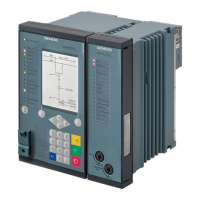Measurands
The general functionality requires the following input measurands:
•
Positive-sequence voltage V1
•
Positive-sequence current I1
•
Positive-sequence system apparent power S1
•
Positive-sequence system active power P1
•
Frequency
S1 and P1 are both calculated from V1 and I1. The frequency is calculated from V1.
The frequency and the frequency change rate df/dt are calculated via the angle difference algorithm. You can
find more information in chapter 7.18.3 Overfrequency-Protection Stage.
Undervoltage Blocking
The frequency of the Underfrequency load shedding function is calculated from the positive-sequence
voltage V1. In order to obtain a reliable and accurate frequency calculation result, the magnitude of V1 is
monitored. If the magnitude of V1 is smaller than the Minimum voltage, all the protection stages are
blocked and the
V1< block
indication is issued.
Power Criterion
If a feeder delivers active power towards the busbar, or if the medium-voltage busbar delivers active power to
the high-voltage busbar, it is meaningless to switch off this feeder or the medium-voltage busbar during the
load-shedding process. The power criterion determines the power-flow direction and includes this information
as a blocking criterion into the load-shedding decision of all protection stages.
The Positive power direction parameter defines the positive active-power flow direction of the func-
tion in relation to the standard forward direction of the protection functionality. You can find more informa-
tion in chapter 7.20.3.2 Application and Setting Notes.
In the following figures, if the power flow is located in the release area which is marked in gray, the protection
stages are released. In the remaining area, the protection stages are blocked.
The release area is configured via the following parameters:
•
The parameter Phi (power criterion) defines the area which limits the range of the power angle.
•
The parameter Min. current (power crit.) defines the minimum positive-sequence current that
must be present to calculate the active power in a reliable way. In the following figures, the minimum
current is indicated as the circle whose center is the origin of the coordinates.
The power criterion is checked only when the following 2 conditions are fulfilled:
•
The positive-sequence current I1 exceeds the threshold Min. current (power crit.), that is, I1 is
out of the circle in the following figures.
•
The undervoltage blocking is not fulfilled, that is, the magnitude of V1 is not smaller than the Minimum
voltage.
The dashed lines in the figures show the dropout characteristics. The dropout differential of the power angle is
1°.
The symbol φ in the following figures represents the setting value of the parameter Phi (power crite-
rion).
Protection and Automation Functions
7.20 Underfrequency Load Shedding
836 SIPROTEC 5, High-Voltage Bay Controller, Manual
C53000-G5040-C015-9, Edition 11.2017

